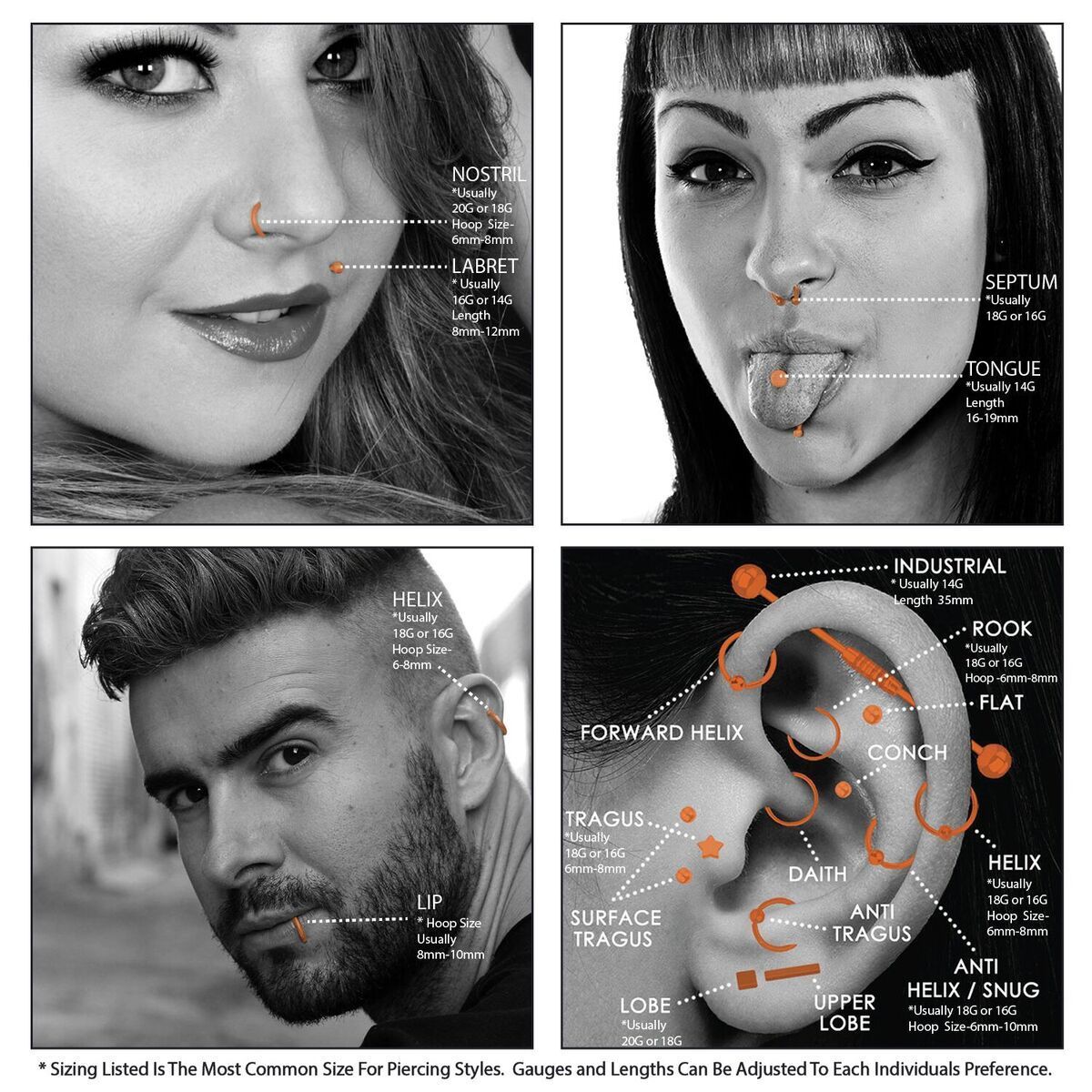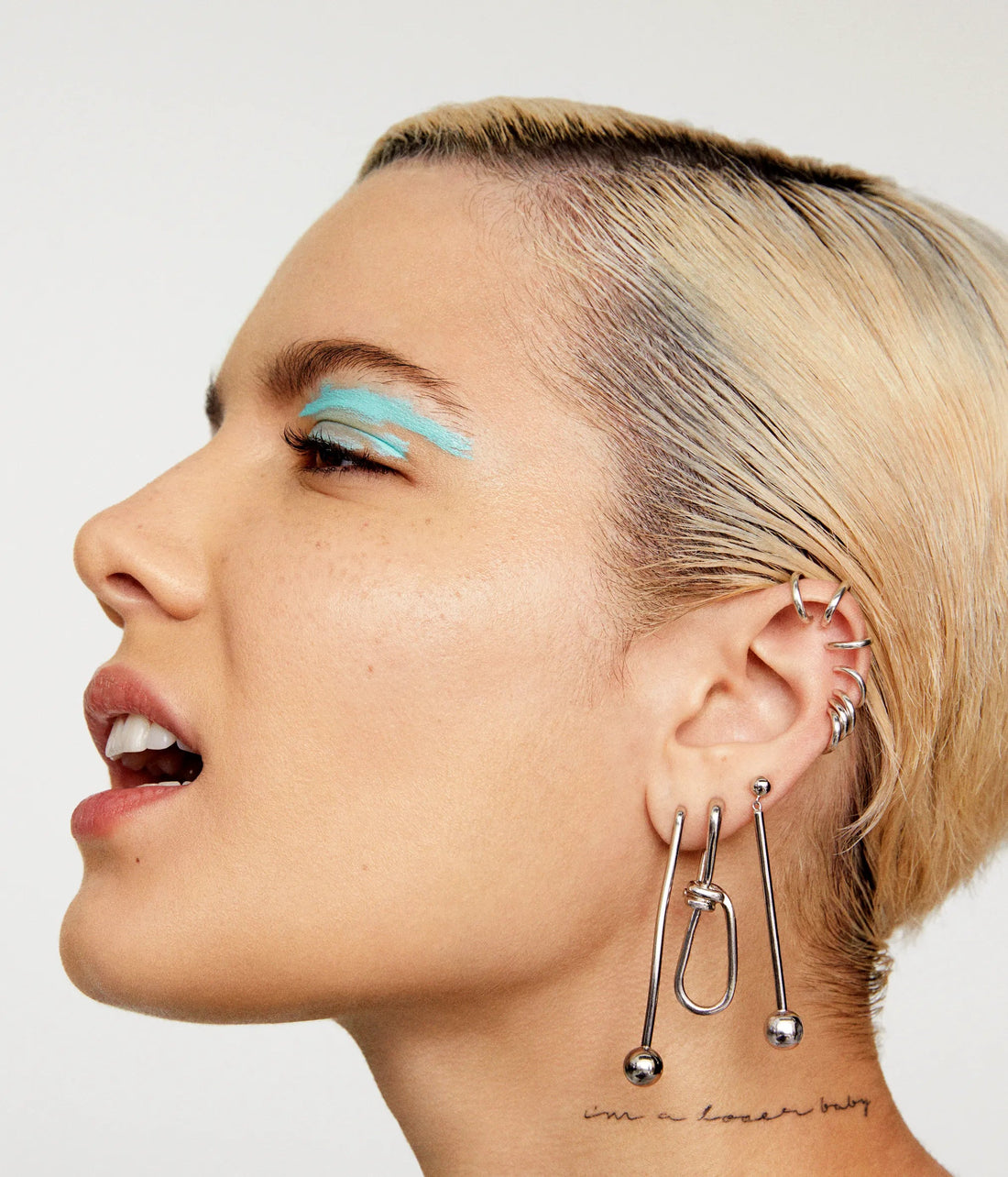There are so many different types of ear piercings one can get that it can be a bit overwhelming to remember the names and sizes of the piercings. As you scroll down you will see a graphic about types of ear piercings, ear stretching size chart and an ear stretching conversion graphic, then a chart about body piercings and their sizes.
The ear piercing graphic below shows the different piercing locations that are most common to get a piercing done.

- Industrial Piercing- sometimes called the bar, scaffold piercing or construction piercing is any two pierced holes connected with a single straight piece of jewelry. Industrial Piercing is a double perforation of the upper ear cartilage specifically. Two piercings are made, one fairly close to the head and the second further down the helix, on the opposite side of the ear. Industrial piercing size usually 14g. Length 16-19mm.
- Rook- Piercing of the cartilage that extends out between the upper half of the conch and the top of the ear. Rook size usually 18g or 16g. Hoop 6mm-8mm.
- Flat- Piercing that sits through the "flat" area of skin between your ear canal and cartilage.
- Conch- Piercing on the lower part of the cartilage inside the ear, where it scoops inward.
- Helix- Piercing goes through the cartilage around the ear. Piercing that pierces the skin that is not fleshy lobe. Size usually 18g or 16g. Hoop size 6-8mm.
- Anti Helix / Snug- Piercing goes through the cartilage along inner edge of the central outer ear, above where the lobe ends. Anti Helix / Snug size usually 18g or 16g. Hoop size 6mm- 8mm.
- Upper Lobe- Piercing that goes through the upper ear lobe where the skin is still soft and fleshy.
- Lobe- Piercing of the ear lobe where the skin is still soft and fleshy. (Most standard ear lobe piercing). Lobe size usually 20g or 18g.
- Anti Tragus- Piercing across from the tragus (see ear piercing diagram above)
- Tragus- Piercing that goes through the thick cartilage in front of the ear canal. Tragus size usually 18g or 16g. 6mm-8mm.
- Surface Tragus- Piercing that traverses through the flesh of cartilage without making a hole.
- Daith- Piercing through the inner ridge of cartilage.
- Forward Helix- Piercing goes through the cartilage at the front of the ear. Directly above where the daith piercing would be & where the helix connects to the head.
Ear Stretching Size Chart

Stretching of the ears is when one gradually increases the size of their initial piercing, usually on the ear lobe. The types of jewelry used are called by many names...plugs, gauges, expanders, tapers, spirals, hollow eyelets.
To learn how to properly stretch your ears read this: https://www.bodyj4you.com/blogs/news/ear-stretching-safety-and-care
VIDEO on how to stretch your ears with a gauges kit and aftercare -

Ear stretching size conversion chart: This chart converts from gauge to millimeters to inches.

Piercing chart: This piercing chart will give you information about the different styles, sizing and how to use the different types of piercing jewelry.

Ear lobe: the gauge (piercing size) is usually at 18g or 20g. The length of an ear lobe piercing is around 6mm-8mm. The types of jewelry worn in an ear lobe piercing are earring studs, hoop earrings, and plugs (ear stretching jewelry).
Cartilage piercing: 14g or 16g is the usual size. The length is around 6mm-8mm. The jewelry worn in a cartilage piercing are studs, small hoops, curved barbell, straight barbell or a horseshoe jewelry piece.
Labret: The labret piercing is usually sized at 14g or 16g with a length of 8mm-12mm. Labret jewelry pieces are flat back studs, horseshoe or labrets.
Monroe: (lip piercing placed off-center and is above the upper lip) The monroe piercing is sized at 16g or 18g with a length of 8mm-12mm. Monroe jewelry is a flat back stud.
Tragus: The tragus piercing is gauged at 16g or 18g with the length being around 6mm-8mm. Jewelry commonly used in a tragus piercing is a round or flat back barbell.
Helix: The helix piercing is sized at 16g or 18g with the length being around 6mm-10mm. Jewelry worn in the helix piercing are hoops, straight or curved barbells, and horseshoe.
Rook: The rook piercing is sized at 16g or 18g with the length being around 6mm-8mm. Jewelry worn in the rook piercing are hoops, straight or curved barbells, and horseshoe.
Conch: The conch piercing is sized at 16g or 18g with the length being around 6mm-8mm. Jewelry worn in the conch piercing are hoops, straight or curved barbells, and horseshoe.
Nostril: The nostril piercing is sized at 18g or 20g with the length being around 6mm. Jewelry worn in the nostril are hoops, L-shape, screw, bone, and fishtail.
Septum: The septum piercing is sized at 16g or 18g. Jewelry worn in the septum piercing are hoops, horseshoe, and retainer pieces.
Tongue: The tongue piercing is sized at 14g with the length being around 16mm. Jewelry worn in a tongue piercing are barbells.
Eyebrow: The eyebrow piercing is sized at 16g with the length being around 8mm-10mm. Jewelry worn in the eyebrow piercing are curved barbells, straight barbells, and horseshoe.
Nipple: The nipple piercing is sized at 12g, 14g or 16g with the length being around 16mm-19mm. Jewelry worn in a nipple piercing are usually curved and straight barbells.
Navel: The navel piercing is sized at 14g with the length being around 8mm-11mm. Jewelry worn in a navel piercing are curved barbells.



Shop Our Best Sellers!



3 comments
Would my beard oil work to lubricate? It has several of the oils you recommend in it. Everything is a natural oil or an essential oil.
hi, i was just wondering for the Flat piercing type how big or a needle would that need and and what earring type would it also need?
Do you have retainers for nipple piercings — I would like to have a discreet a retainer as possible — do you have a nipple piercing kit or kits if so which would you reccommend